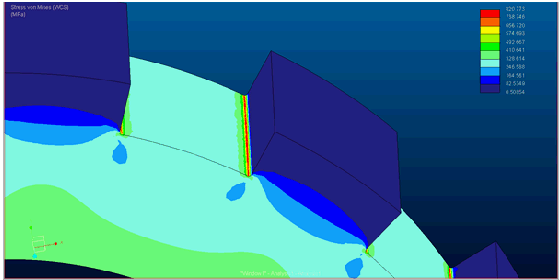Community Tip - Learn all about PTC Community Badges. Engage with PTC and see how many you can earn! X
- Community
- Creo+ and Creo Parametric
- 3D Part & Assembly Design
- Re: High local stress at inside corner
- Subscribe to RSS Feed
- Mark Topic as New
- Mark Topic as Read
- Float this Topic for Current User
- Bookmark
- Subscribe
- Mute
- Printer Friendly Page
High local stress at inside corner
- Mark as New
- Bookmark
- Subscribe
- Mute
- Subscribe to RSS Feed
- Permalink
- Notify Moderator
High local stress at inside corner
We are trying to simulate a toothed-ring with radial loads outwards due to a shrink fit and rotation. In the corners of the valleys between the teeth, the stress is incredibly high compared to the stress in the rest of the part (see screen shot below with a thin red line at the inside corner).
Is this stress real? Should we simulate differently?
Thanks in advance for any advice.

This thread is inactive and closed by the PTC Community Management Team. If you would like to provide a reply and re-open this thread, please notify the moderator and reference the thread. You may also use "Start a topic" button to ask a new question. Please be sure to include what version of the PTC product you are using so another community member knowledgeable about your version may be able to assist.
Solved! Go to Solution.
- Labels:
-
General
Accepted Solutions
- Mark as New
- Bookmark
- Subscribe
- Mute
- Subscribe to RSS Feed
- Permalink
- Notify Moderator
Yes and no.
If it is above the yield strength of the material the material will yield, lowering the stress in that area to the yield stress. Otherwise it is a significant stress concentrator/stress riser. If there is cyclic loading, this is where the part will fatigue and crack.
Anytime there is a rapid (dArea/dx or dSection Inertia/dx) change in section under a load the otherwise unsupported load has to go somewhere. Even a large-radius undercut will lower the stress.
Happily it also makes pop-top soda cans work.
- Mark as New
- Bookmark
- Subscribe
- Mute
- Subscribe to RSS Feed
- Permalink
- Notify Moderator
You have a stress riser in that corner. Try a generous radius. It is probably trying to "peel" the tooth away.
- Mark as New
- Bookmark
- Subscribe
- Mute
- Subscribe to RSS Feed
- Permalink
- Notify Moderator
Yes and no.
If it is above the yield strength of the material the material will yield, lowering the stress in that area to the yield stress. Otherwise it is a significant stress concentrator/stress riser. If there is cyclic loading, this is where the part will fatigue and crack.
Anytime there is a rapid (dArea/dx or dSection Inertia/dx) change in section under a load the otherwise unsupported load has to go somewhere. Even a large-radius undercut will lower the stress.
Happily it also makes pop-top soda cans work.
- Mark as New
- Bookmark
- Subscribe
- Mute
- Subscribe to RSS Feed
- Permalink
- Notify Moderator
The stress is real in linear world but not in elastic-plastic world.
Elasto-plastic analysis will drop the stress, strain will increase. Stay below ultimate tensile strain.
Don't use vm stress.
Do the teeth drive anything?
- Mark as New
- Bookmark
- Subscribe
- Mute
- Subscribe to RSS Feed
- Permalink
- Notify Moderator
Thank you for your response, that makes sense. Does Mechanica/Simulate do elasto-plastic analysis? We've never looked for it.
Thanks again!
- Mark as New
- Bookmark
- Subscribe
- Mute
- Subscribe to RSS Feed
- Permalink
- Notify Moderator
I guess you have to create a material with those properties at least.
Not sure what needs to be done for the analysis, but maybe this helps
- Mark as New
- Bookmark
- Subscribe
- Mute
- Subscribe to RSS Feed
- Permalink
- Notify Moderator
No, the teeth don't have any loads on them, so we don't need to worry about fatigue from cyclic loading. We have been experimenting with the elastic/plastic analysis and are getting results that are more rational once plastic deformation is modeled.
Thanks again!
Jeff
- Mark as New
- Bookmark
- Subscribe
- Mute
- Subscribe to RSS Feed
- Permalink
- Notify Moderator
Thanks! We have already been experimenting with a radius, but other constraints mean that even a big one doesn't quite fix it, though it does help.
- Mark as New
- Bookmark
- Subscribe
- Mute
- Subscribe to RSS Feed
- Permalink
- Notify Moderator
Do the teeth drive anything?
Will they see variable tangential loading?
- Mark as New
- Bookmark
- Subscribe
- Mute
- Subscribe to RSS Feed
- Permalink
- Notify Moderator
Jeff, is that the area of the highest stress? If so, to what % did the max_vm_stress measure converge to? What do your constraints and loads look like?
- Mark as New
- Bookmark
- Subscribe
- Mute
- Subscribe to RSS Feed
- Permalink
- Notify Moderator
I will look at the convergence, that's a good idea. But yes, that is the area of highest stress, according to Simulate. Things are looking better using the elastic/plastic analysis.
Thanks again!
Jeff





